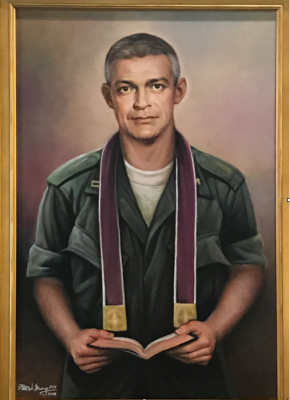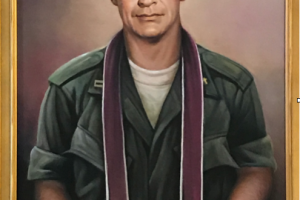On Veterans Day, Sunday November 11, 2018, a new portrait of Servant of God Father Vincent R. Capodanno MM was unveiled at the National Museum of the Marine Corps in Quantico, VA. The portrait was painted by the Artist-in-Residence of the North American Province of the Society of St Sulpice, Father Peter W. Gray, PSS, Ph.D.
Father Capodanno is presently a candidate for sainthood whose cause, initiated by the Archdiocese for Military Services, is now being considered in Rome. He was a United States Navy chaplain, served with the Marines in Vietnam, and was posthumously awarded the Congressional Medal of Honor.
Among those present at the unveiling were Father Capodanno’s niece Linda Capodanno Sargent, other nieces and nephews and their children, Father Daniel L. Mode MM, author of his biography The Grunt Padre, and his first Postulator, the President of the Marine Corps Heritage Foundation LtGen Robert R. Blackman, Jr, USMC (Ret), members of the Board of the Capodanno Guild including VADM P. Stephen Stanley, USN (Ret), BGen Thomas V. Draude, USMC (Ret), Father Capodanno’s company commander and several of the men who were with Father Capodanno on the day he earned the Medal of Honor.
Father Capodanno was ordained with the Maryknoll Missionaries. His first assignment was to Taiwan, where he learned the Taiwanese dialect, lived with local villagers, and headed a school for Taiwanese students studying for the critical university entrance exams. After six years in Taiwan, Father Capodanno learned that his next assignment was to be in Hong Kong.
At that time, however, he felt a different calling – a call to serve the increasing number of Marines being sent to Vietnam. As a result, Father Capodanno was released from the Foreign Mission Society, attended Officer Candidate School and Marine basic training, and arrived in Vietnam during Holy Week 1966. From the very first, Father Capodanno devoted his time to the “grunts,” the enlisted Marines who were in the thick of the fighting.
Father Capodanno lived among his Marines, who, at his last post, were spread out  over 25 square miles of hostile territory. He squeezed into helicopters heading to combat, moved among the Marines talking, reassuring, celebrating the Mass, hearing confessions, giving absolution and last rites, and cadging cigarettes.
over 25 square miles of hostile territory. He squeezed into helicopters heading to combat, moved among the Marines talking, reassuring, celebrating the Mass, hearing confessions, giving absolution and last rites, and cadging cigarettes.
His division chaplain, John Keeley, said that “He just wanted to be with the grunts. He was more a Marine than anything else.” He loved his men and they loved him. After his first year in Vietnam ended, he extended his tour of duty to remain with them.
The word went out that “we have to protect our Padre” because Father Capodanno would dash to the aid of any Marine who needed him, no matter what the risk.
On his final day in combat, 4 September 1967, Father Capodanno found a place on the last helicopter taking a company of Marines to an outpost where 500 Marines faced 2,500 North Vietnam Army regulars. His company commander did not even know he was there, as he headed straight toward the sound of guns with his Marines.
The citation for Father Capodanno’s Congressional Medal of Honor describes what happened that day:
“In response to reports that the 2d Platoon of M Company [3rd Battalion, 5th Marines] was in danger of being overrun by a massed enemy assaulting force, Lt. Capodanno left the relative safety of the company command post and ran through an open area raked with fire, directly to the beleaguered platoon. Disregarding the intense enemy small-arms, automatic-weapons, and mortar fire, he moved about the battlefield administering last rites to the dying and giving medical aid to the wounded. When an exploding mortar round inflicted painful multiple wounds to his arms and legs, and severed a portion of his right hand, he steadfastly refused all medical aid. Instead, he directed the corpsmen to help their wounded comrades and, with calm vigor, continued to move about the battlefield as he provided encouragement by voice and example to the valiant marines. Upon encountering a wounded corpsman in the direct line of fire of an enemy machine gunner positioned approximately 15 yards away, Lt. Capodanno rushed a daring attempt to aid and assist the mortally wounded corpsman. At that instant, only inches from his goal, he was struck down by a burst of machine gun fire.”
The Capodanno Guild was formed in 2013 to promote the cause for canonization of Father Capodanno.
The Guild commissioned Father Gray to paint Father Capodanno’s portrait, with the intention that this portrait will hang in the chapel at the Archdiocese for Military Services with Father Capodanno’s relics once the so-called Grunt Padre is beatified. Until then, the portrait will be on display at the National Museum of the Marine Corps.
Artist Father Gray spoke at the unveiling about how he painted the portrait. He examined thousands of photographs of Father Capodanno, spoke to members of the Guild and to Father Capodanno’s family, and read Father Mode’s biography. Then Father Gray made sketches of possible portraits. His first suggestion was to depict Father Capodanno celebrating Mass and giving the final blessing with American Flag as background and Father Capodanno’s last remembered words, “Do Not be Afraid…”.
The Guild had different ideas. They suggested showing Father Capodanno at a typewriter, since he spent much of his time when not in the field typing letters for his Marines. Father Gray vetoed that idea. They all came together in agreement that the most important element to capture was Father Capodanno’s eyes. That dictated that Father Capodanno be portrayed facing forward.
Those who knew him also described how Father Capodanno became more gaunt and gray during his time in Vietnam, as he shared the short rations and stresses of his Marines, so that Father Gray could depict him as he was in country. That led to the sketch of the pose that was chosen.
The Guild had different ideas. They suggested showing Father Capodanno at a typewriter, since he spent much of his time when not in the field typing letters for his Marines. Father Gray vetoed that idea. They all came together in agreement that the most important element to capture was Father Capodanno’s eyes. That dictated that Father Capodanno be portrayed facing forward.
Those who knew him also described how Father Capodanno became more gaunt and gray during his time in Vietnam, as he shared the short rations and stresses of his Marines, so that Father Gray could depict him as he was in country. That led to the sketch of the pose that was chosen:
RELATED RESOURCES:
- Father Capodanno Guild. Signed and numbered lithographs are available from the Capodanno Guild for a $150 contribution. All of the Guild’s funds are used to support the investigations required to establish Father Capodanno’s sainthood.
- Anyone interested in the worthy project of sainthood should contact Mary Preece, Vice Postulator for Father Capodanno’s Cause for Canonization at 202-719-3642 or mpreece@milarch.org.
- Reports of favors granted due to Father Capodanno’s intercession should also be reported to Mary Preece (see contact information above)
- BOOK: The Grunt Padre: Father Vincent Robert Capodanno, Vietnam, 1966-1967, by Father Daniel L. Mode
- Profits from Fr. Gray’s works assist his small mission in Nepal, which he began as an NGO 20 years ago, as well as locally with the street people and homeless in Baltimore



You must be logged in to post a comment.